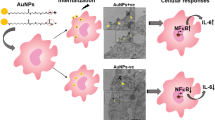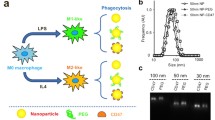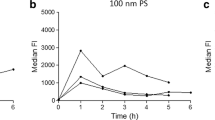Abstract
Purpose
To demonstrate that polyanhydride copolymer chemistry affects the uptake and intracellular compartmentalization of nanospheres by THP-1 human monocytic cells.
Methods
Polyanhydride nanospheres were prepared by an anti-solvent nanoprecipitation technique. Morphology and particle diameter were confirmed via scanning election microscopy and quasi-elastic light scattering, respectively. The effects of varying polymer chemistry on nanosphere and fluorescently labeled protein uptake by THP-1 cells were monitored by laser scanning confocal microscopy.
Results
Polyanhydride nanoparticles composed of poly(sebacic anhydride) (SA), and 20:80 and 50:50 copolymers of 1,6-bis-(p-carboxyphenoxy)hexane (CPH) anhydride and SA were fabricated with similar spherical morphology and particle diameter (200 to 800 nm). Exposure of the nanospheres to THP-1 monocytes showed that poly(SA) and 20:80 CPH:SA nanospheres were readily internalized whereas 50:50 CPH:SA nanospheres had limited uptake. The chemistries also differentially enhanced the uptake of a red fluorescent protein-labeled antigen.
Conclusions
Nanosphere and antigen uptake by monocytes can be directly correlated to the chemistry of the nanosphere. These results demonstrate the importance of choosing polyanhydride chemistries that facilitate enhanced interactions with antigen presenting cells that are necessary in the initiation of efficacious immune responses.





Similar content being viewed by others
References
I. Preis, and R. S. Langer. A single-step immunization by sustained antigen release. J. Immunol. Methods. 28(1–2):193–197 (1979) doi:10.1016/0022-1759(79)90341-7.
J. H. Wilson-Welder et al. Vaccine adjuvants: Current challenges and future approaches. J. Pharm. Sci. 2008.
S. P. Schwendeman. Recent advances in the stabilization of proteins encapsulated in injectable PLGA delivery systems. Crit. Rev. Ther. Drug Carr. Syst. 19:73–98 (2002) doi:10.1615/CritRevTherDrugCarrierSyst.v19.i1.20.
A. Gopferich. Polymer bulk erosion. Macromolecules. 30:2598–2604 (1997) doi:10.1021/ma961627y.
Y. Wang et al. Controlled release of ethacrynic acid from poly(lactide-co-glycolide) films for glaucoma treatment. Biomaterials. 25(18):4279–4285 (2004) doi:10.1016/j.biomaterials.2003.10.075.
K. Fu et al. Visual evidence of acidic environment within degrading poly(lactic-co-glycolic acid) (PLGA) microspheres. Pharm. Res. 17(1):100–106 (2000) doi:10.1023/A:1007582911958.
A. G. Ding, and S. P. Schwendeman. Acidic microclimate pH distribution in PLGA microspheres monitored by confocal laser scanning microscopy. Pharm. Res. 25(9):2041–2052 (2008) doi:10.1007/s11095-008-9594-3.
A. S. Determan et al. Protein stability in the presence of polymer degradation products: consequences for controlled release formulations. Biomaterials. 27(17):3312–3320 (2006) doi:10.1016/j.biomaterials.2006.01.054.
A. S. Determan et al. Encapsulation, stabilization, and release of BSA-FITC from polyanhydride microspheres. J. Control. Release. 100(1):97–109 (2004) doi:10.1016/j.jconrel.2004.08.006.
G. Zhu, S. R. Mallery, and S. P. Schwendeman. Stabilization of proteins encapsulated in injectable poly(lactic-co-glycolic acid). Nat. Biotechnol. 18:52–57 (2000) doi:10.1038/71916.
M. J. Kipper et al. Design of an injectable system based on bioerodible polyanhydride microspheres for sustained drug delivery. Biomaterials. 23(22):4405–4412 (2002) doi:10.1016/S0142-9612(02)00181-3.
E. Shen et al. Mechanistic relationships between polymer microstructure and drug release kinetics in bioerodible polyanhydrides. J. Control. Release. 82(1):115–125 (2002) doi:10.1016/S0168-3659(02)00125-6.
E. Ron et al. Controlled release of polypeptides from polyanhydrides. Proc. Natl. Acad. Sci. USA. 90(9):4176–4180 (1993) doi:10.1073/pnas.90.9.4176.
L. Shieh et al. Erosion of a new family of biodegradable polyanhydrides. J. Biomed. Materi. Res. 28(12):1465–1475 (1994) doi:10.1002/jbm.820281212.
J. P. Jain et al. Role of polyanhydrides as localized drug carriers. J. Control. Release. 103(3):541–563 (2005) doi:10.1016/j.jconrel.2004.12.021.
A. S. Determan et al. The role of microsphere fabrication methods on the stability and release kinetics of ovalbumin encapsulated in polyanhydride microspheres. J. Microencapsul. 23(8):832–843 (2006) doi:10.1080/02652040601033841.
Y. Tabata, S. Gutta, and R. Langer. Controlled delivery systems for proteins using polyanhydride microspheres. Pharm. Res. 10(4):487–496 (1993) doi:10.1023/A:1018929531410.
B. A. Pfeifer et al. Poly(ester-anhydride):poly(beta-amino ester) microspheres and nanospheres: DNA encapsulation and cellular transfection. Int. J. Pharm. 304(1–2):210–219 (2005) doi:10.1016/j.ijpharm.2005.08.001.
N. B. Shelke, and T. M. Aminabhavi. Synthesis and characterization of novel poly(sebacic anhydride-co-Pluronic F68/F127) biopolymeric microspheres for the controlled release of nifedipine. Int. J. Pharm. 345(1–2):51–58 (2007) doi:10.1016/j.ijpharm.2007.05.036.
W. Hsu et al. Local delivery of interleukin-2 and adriamycin is synergistic in the treatment of experimental malignant glioma. J. Neurooncol. 74(2):135–140 (2005) doi:10.1007/s11060-004-6597-8.
J. Hanes, M. Chiba, and R. Langer. Degradation of porous poly(anhydride-co-imide) microspheres and implications for controlled macromolecule delivery. Biomaterials. 19(1–3):163–172 (1998) doi:10.1016/S0142-9612(97)00221-4.
M. J. Kipper et al. Single dose vaccine based on biodegradable polyanhydride microspheres can modulate immune response mechanism. J. Biomed. Materi. Res. Part A. 76(4):798–810 (2006) doi:10.1002/jbm.a.30545.
C. Berkland et al. Microsphere size, precipitation kinetics and drug distribution control drug release from biodegradable polyanhydride microspheres. J. Control. Release. 94(1):129–141 (2004) doi:10.1016/j.jconrel.2003.09.011.
F. X. Lacasse et al. Influence of surface properties at biodegradable microsphere surfaces: effects on plasma protein adsorption and phagocytosis. Pharm. Res. 15(2):312–317 (1998) doi:10.1023/A:1011935222652.
J. A. Schwab, and M. Zenkel. Filtration of particulates in the human nose. Laryngoscope. 108(1):120–124 (1998) doi:10.1097/00005537-199801000-00023.
P. A. Jaques, and C. S. Kim. Measurement of total lung deposition of inhaled ultrafine particles in healthy men and women. Inhal. Toxicol. 12(8):715–731 (2000) doi:10.1080/08958370050085156.
M. P. Desai et al. Gastrointestinal uptake of biodegradable microparticles: effect of particle size. Pharm. Res. 13(12):1838–1845 (1996) doi:10.1023/A:1016085108889.
T. Jung et al. Tetanus toxoid loaded nanoparticles from sulfobutylated poly(vinyl alcohol)-gradt-poly(lactide-co-glycolide): evaluation of antibody response after oral and nasal application in mice. Pharm. Res. 18(3):352–360 (2001) doi:10.1023/A:1011063232257.
L. Illum. Nanoparticulate systems for nasal delivery of drugs: a real improvement over simple systems? J. Pharm. Sci. 96(3):473–483 (2007) doi:10.1002/jps.20718.
M. P. Desai et al. The mechanism of uptake of biodegradable microparticles in Caco-2 cells is size dependent. Pharm. Res. 14(11):1568–1573 (1997) doi:10.1023/A:1012126301290.
J. E. Fuller et al. Intracellular delivery of core-shell fluorescent silica nanoparticles. Biomaterials. 29(10):1526–1532 (2008) doi:10.1016/j.biomaterials.2007.11.025.
A. Conix. Poly[1,3-bis(p-carboxyphenoxy)propane anhydride]. Macromolecular Synthesis. 2:95–98 (1966).
E. Mathiowitz et al. Biologically erodible microspheres as potential oral drug delivery systems. Nature. 386(6623):410–414 (1997) doi:10.1038/386410a0.
R. W. Stokes, and D. Doxsee. The receptor-mediated uptake, survival, replication, and drug sensitivity of Mycobacterium tuberculosis within the macrophage-like cell line THP-1: a comparison with human monocyte-derived macrophages. Cell. Immunol. 197(1):1–9 (1999) doi:10.1006/cimm.1999.1554.
B. H. Bellaire, R. M. Roop II, and J. A. Cardelli. Opsonized virulent Brucella abortus replicates within nonacidic, endoplasmic reticulum-negative, LAMP-1-positive phagosomes in human monocytes. Infecation and Immunity. 73(6):3702–3713 (2005) doi:10.1128/IAI.73.6.3702-3713.2005.
ImageJ. Image Processing and Analysis in Java [cited 2008 August 3rd]; Available from: http://rsb.info.nih.gov/ij/.
A. A. Itano et al. Distinct dendritic cell populations sequentially present antigen to CD4 T cells and stimulate different aspects of cell-mediated immunity. Immunity. 19(1):47–57 (2003) doi:10.1016/S1074-7613(03)00175-4.
E. Mathiowitz, et al. Process for preparing microparticles through phase inversion phenomena. 2003: United States of America.
P. Lajoie, and I. R. Nabi. Regulation of raft-dependent endocytosis. J. Cell. Mol. Med. 11(4):644–653 (2007) doi:10.1111/j.1582-4934.2007.00083.x.
N. Gupta, and A. L. DeFranco. Visualizing lipid raft dynamics and early signaling events during antigen receptor-mediated B-lymphocyte activation. Mol. Biol. Cell. 14(2):432–444 (2003) doi:10.1091/mbc.02-05-0078.
Z. Wolf et al. Monocyte cholesterol homeostasis correlates with the presence of detergent resistant membrane microdomains. Cytometry Part A. 71(7):486–494 (2007) doi:10.1002/cyto.a.20403.
S. Y. Seong, and P. Matzinger. Hydrophobicity: an ancient damage-associated molecular pattern that initiates innate immune responses. Nat. Rev. Immunol. 4(6):469–478 (2004) doi:10.1038/nri1372.
M. G. Netea et al. From the Th1/Th2 paradigm towards a Toll-like receptor/T-helper bias. Antimicrob. Agents Chemother. 49(10):3991–3996 (2005) doi:10.1128/AAC.49.10.3991-3996.2005.
P. Elamanchili et al. “Pathogen-mimicking” nanoparticles for vaccine delivery to dendritic cells. J. Immunother. 30(4):378–395 (2007) doi:10.1097/CJI.0b013e31802cf3e3.
A. L. Goldberg et al. The importance of the proteasome and subsequent proteolytic steps in the generation of antigenic peptides. Mol. Immunol. 39(3–4):147–164 (2002) doi:10.1016/S0161-5890(02)00098-6.
E. M. Hiltbold, and P. A. Roche. Trafficking of MHC class II molecules in the late secretory pathway. Curr. Opin. Immunol. 14(1):30–35 (2002) doi:10.1016/S0952-7915(01)00295-3.
Acknowledgments
B.N. and M.J.W. acknowledge financial support from the US Department of Defense—Office of Naval Research (ONR Award no. N00014-06-1-1176) and the Grow Iowa Values Fund. B.H.B. acknowledges startup funds provided by Iowa State University-College of Veterinary Medicine and the Office of Biotechnology. B.D.U acknowledges financial support from the Aileen S. Andrew Foundation. The authors acknowledge useful discussions with Dr. Amanda Ramer-Tait and Jenny Wilson-Welder. B.N. dedicates this work to Nicholas A. Peppas on the wonderful occasion of his sixtieth birthday.
Author information
Authors and Affiliations
Corresponding authors
Rights and permissions
About this article
Cite this article
Ulery, B.D., Phanse, Y., Sinha, A. et al. Polymer Chemistry Influences Monocytic Uptake of Polyanhydride Nanospheres. Pharm Res 26, 683–690 (2009). https://doi.org/10.1007/s11095-008-9760-7
Received:
Accepted:
Published:
Issue Date:
DOI: https://doi.org/10.1007/s11095-008-9760-7




